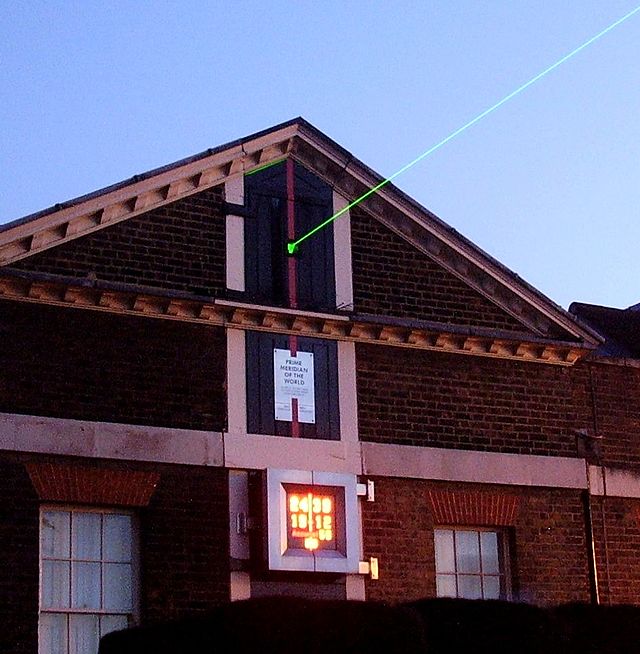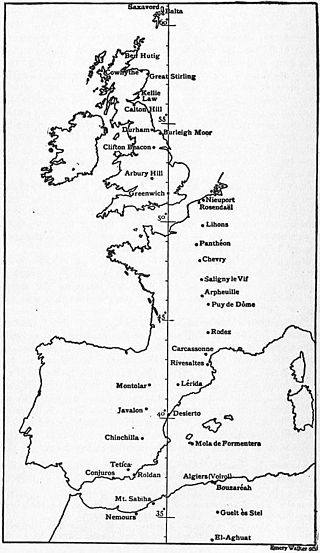Prime meridian (Greenwich)
Meridian passing through Greenwich, London From Wikipedia, the free encyclopedia


The Greenwich meridian is a prime meridian, a geographical reference line that passes through the Royal Observatory, Greenwich, in London, England.[1] From 1884 to 1974, the Greenwich meridian was the international standard prime meridian, used worldwide for timekeeping and navigation. The modern standard, the IERS Reference Meridian, is based on the Greenwich meridian, but differs slightly from it.[1] This prime meridian (at the time, one of many) was first established by Sir George Airy (in 1851). In 1883, the International Geodetic Association formally recommended to governments that the meridian through Greenwich be adopted as the international standard prime meridian. In October of the following year, at the invitation of the President of the United States, 41 delegates from 25 nations met in Washington, D.C., United States, for the International Meridian Conference.[2] This inter-governmental conference selected the meridian passing through Greenwich as the world standard prime meridian.[a] However, France abstained from the vote, and French maps continued to use the Paris meridian for several decades. In the 18th century, London lexicographer Malachy Postlethwayt published his African maps showing the "Meridian of London" intersecting the Equator a few degrees west of the later meridian and Accra, Ghana.[4]
The plane of the prime meridian contains the local gravity vector at the Airy transit circle instrument (51°28′40.1″N 0°0′5.3″W)[5] of the Greenwich observatory. The prime meridian was therefore long symbolised by a brass strip in the courtyard, now replaced by stainless steel, and since 16 December 1999, it has been marked by a powerful green laser shining north across the London night sky.
The Global Positioning System (GPS) receivers show that the marking strip for the prime meridian at Greenwich is not exactly at zero longitude (zero degrees, zero minutes, and zero seconds) but at approximately 5.3 seconds of arc to the west of the meridian, meaning that the meridian appears to be 102 metres east. In the past, this offset has been attributed to the establishment of reference meridians for space-based location systems such as WGS-84 (which the GPS relies on) or to the fact that errors gradually crept into the International Time Bureau timekeeping process. The actual reason for the discrepancy is that the difference between geodetic coordinates and astronomically determined coordinates everywhere remains a localized gravity effect due to vertical deflection; thus, no systematic rotation of global longitudes occurred between the former astronomical system and the current geodetic system.[5]
History
Summarize
Perspective

Before the establishment of a common international prime meridian, most maritime countries established their own prime meridians, usually passing through the national observatory or other landmark in the country in question. In January 1851, the Royal Observatory at Greenwich established the prime meridian for Great Britain.[6]
In the 19th century, astronomers and geodesists were concerned with questions of longitude and time, because they were responsible for determining them scientifically and used them continually in their studies. The International Geodetic Association, which had covered Europe with a network of fundamental longitudes, took an interest in the question of an internationally-accepted prime meridian at its seventh general conference in Rome in 1883.[7] Indeed, the Association was already providing administrations with the bases for topographical surveys, and engineers with the fundamental benchmarks for their levelling. It seemed natural that it should contribute to the achievement of significant progress in navigation, cartography and geography, as well as in the service of major communications institutions, railways and telegraphs.[8] From a scientific point of view, to be a candidate for the status of international prime meridian, the proponent needed to satisfy three important criteria. According to the report by Carlos Ibáñez e Ibáñez de Ibero, it must have a first-rate astronomical observatory, be directly linked by astronomical observations to other nearby observatories, and be attached to a network of first-rate triangles in the surrounding country.[8] Four major observatories could satisfy these requirements: Greenwich, Paris, Berlin and Washington. The conference concluded that Greenwich Observatory best corresponded to the geographical, nautical, astronomical and cartographic conditions that guided the choice of an international prime meridian, and recommended the governments should adopt it as the world standard.[9] The Conference further hoped that, if the whole world agreed on the unification of longitudes and times by the Association's choosing the Greenwich meridian, Great Britain might respond in favour of the unification of weights and measures, by adhering to the Metre Convention.[10]
In 1884, the International Meridian Conference (of government representatives) took place in Washington, D.C. to establish an internationally-recognised single meridian. The meridian chosen was that which passed through the Airy transit circle at Greenwich, and it became the prime meridian of the world for a century. In 1984 it was superseded in that role by the IERS Reference Meridian which, at this latitude, runs about 102 metres to the east of the Greenwich meridian.
At around the time of the 1884 conference, scientists were making measurements to determine the deflection of the vertical on a large scale.[11] One might expect that plumb lines set up in various locations, if extended downward, would all pass through a single point, the centre of Earth, but this is not the case, primarily due to Earth being an ellipsoid, not a sphere. The downward extended plumb lines don't even all intersect the rotation axis of Earth; this much smaller effect is due to the uneven distribution of Earth's mass. To make computations feasible, scientists defined ellipsoids of revolution, more closely emulating the shape of Earth, modified for a particular zone; a published ellipsoid would be a good base line for measurements. The difference between the direction of a plumb line or vertical, and a line perpendicular to the surface of the ellipsoid of revolution – a normal to said ellipsoid – at a particular observatory, is the deflection of the vertical.[12]
IERS Reference Meridian
Summarize
Perspective

When the Airy transit circle was built, a mercury basin was used to align the telescope to the perpendicular. Thus the circle was aligned with the local vertical or plumb line, which is deflected slightly from the normal, or line perpendicular, to the reference ellipsoid used to define geodetic latitude and longitude in the International Terrestrial Reference Frame (which is nearly the same as the WGS84 system used by the GPS). While Airy's local vertical, set by the apparent centre of gravity of Earth still points to (aligns with) the modern celestial meridian (the intersection of the prime meridian plane with the celestial sphere), it does not pass through Earth's rotation axis. As a result of this, the ITRF zero meridian, defined by a plane passing through Earth's rotation axis, is 102.478 metres to the east of the prime meridian. A 2015 analysis by Malys et al. shows the offset between the former and the latter can be explained by this deflection of the vertical alone; other possible sources of the offset that have been proposed in the past are smaller than the current uncertainty in the deflection of the vertical, locally. The astronomical longitude of the Greenwich prime meridian was found to be 0.19″ ± 0.47″ E, i.e. the plane defined by the local vertical on the Greenwich prime meridian and the plane passing through Earth's rotation axis on the ITRF zero meridian are effectively parallel. Claims, such as that on the BBC website, that the gap between astronomical and geodetic coordinates means that any measurements of transit time across the IRTF zero meridian will occur precisely 0.352 seconds (or 0.353 sidereal seconds) before the transit across the "intended meridian"[13] are based on a failure of understanding. The explanation by Malys et al. on the other hand is more studied and correct.[5]
Meridian today

The Greenwich meridian passes through eight countries in Europe and Africa from north to south:
- United Kingdom (specifically, only England)
- France
- Spain
- Algeria
- Mali
- Burkina Faso
- Togo
- Ghana
It also passes through Antarctica, only touching Queen Maud Land, a territorial claim of Norway, on its way from the North Pole to the South Pole.
It crosses the maritime exclusive economic zones of:
- Greenland (Denmark)
- Norway (via proximity to Svalbard, Jan Mayen Island, and the Norwegian mainland in the North Atlantic, and Bouvet Island in the South Atlantic)
See also
Notes
- Voting took place on 13 October and the resolutions were adopted on 22 October 1884.[3]
References
Sources
External links
Wikiwand - on
Seamless Wikipedia browsing. On steroids.
